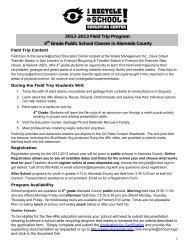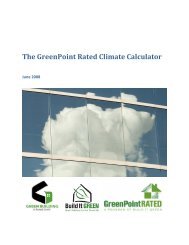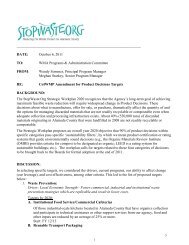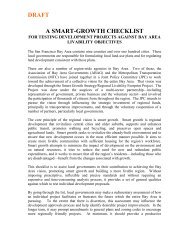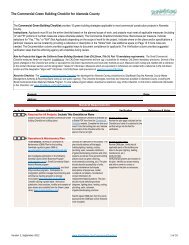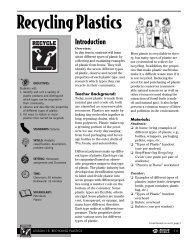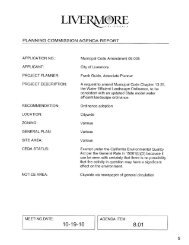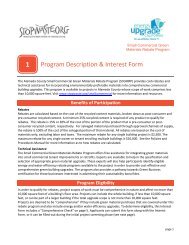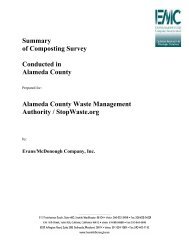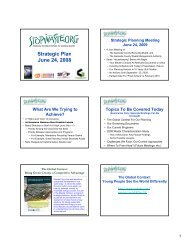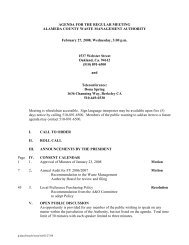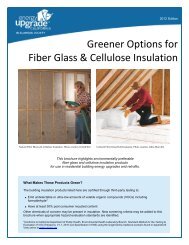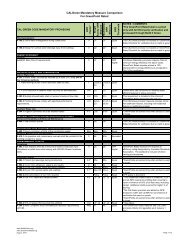Bay-Friendly Landscaping Principles and Practices - StopWaste.org
Bay-Friendly Landscaping Principles and Practices - StopWaste.org
Bay-Friendly Landscaping Principles and Practices - StopWaste.org
You also want an ePaper? Increase the reach of your titles
YUMPU automatically turns print PDFs into web optimized ePapers that Google loves.
<strong>Principles</strong><br />
& <strong>Practices</strong><br />
1. Remove <strong>and</strong> store topsoil<br />
before grading<br />
Description<br />
Topsoil is a valuable resource, yet it is<br />
typically removed or mixed with subsoil<br />
during construction, beginning a cycle of<br />
high water <strong>and</strong> chemical dependency.<br />
Applications<br />
When grading the soil is unavoidable:<br />
n Identify areas that are to be paved<br />
as a place to store topsoil during<br />
construction.<br />
n Remove the topsoil (at least the top<br />
6 inches if the topsoil is deep) before<br />
other grading <strong>and</strong> store for future use.<br />
n Do not store in piles larger than 6 feet<br />
high.<br />
n Protect from erosion.<br />
n Send samples for analysis.<br />
n Amend with 20-35% compost,<br />
depending on soil type <strong>and</strong> analysis,<br />
compost quality <strong>and</strong> plant selection.<br />
n Re-spread after grading <strong>and</strong><br />
construction.<br />
Benefits<br />
Conserving topsoil can reduce the<br />
likelihood of many problems over the<br />
long run, including stormwater runoff.<br />
It can minimize fertilizer <strong>and</strong> irrigation<br />
requirements <strong>and</strong> topsoil replacement<br />
costs.<br />
2. Protect soil from<br />
compaction<br />
Description<br />
Heavy equipment can compact soil as<br />
deep as two feet below the surface of<br />
the soil. Compacted soils do not have<br />
adequate space for air or water.<br />
Application<br />
n Before construction begins, specify<br />
a limited construction area. Install<br />
temporary fences to restrict heavy<br />
equipment, including cars. Areas that<br />
will be paved or built over are good<br />
sites for parking equipment.<br />
n Don’t assume you need the biggest,<br />
heaviest equipment.<br />
n If using heavy equipment, select those<br />
with flotation tires or wide tracks to<br />
distribute the load.<br />
n On a longer-term basis, limit foot<br />
traffic, especially during the wet<br />
season.<br />
n Do not work soil when it is too wet<br />
or too dry. Till as little as possible,<br />
<strong>and</strong> only with a clearly identified goal,<br />
such as incorporating <strong>org</strong>anic matter.<br />
Loosen the soil with a fork instead of<br />
turning it over whenever possible.<br />
Benefits<br />
Soil structure <strong>and</strong> the soil’s ability to<br />
support the microbes that cycle nutrients<br />
<strong>and</strong> filter pollutants are protected. The<br />
soil is easier to work.<br />
Why Use Compost for<br />
Erosion Control<br />
n Compost blankets <strong>and</strong> compost<br />
filter berms are less expensive<br />
when construction, maintenance,<br />
removal <strong>and</strong> disposal costs are<br />
considered.<br />
n Compost blankets <strong>and</strong> filter berms<br />
provide chemical, biological <strong>and</strong><br />
physical filtration.<br />
n They work better than st<strong>and</strong>ard<br />
BMP’s like silt fences or straw bales.<br />
n Berms offer more actual filtration<br />
than coir rolls, silt fences or straw<br />
bales.<br />
n Compost is annually renewable.<br />
n Compost is 100% recycled.<br />
n Compost is all <strong>org</strong>anic <strong>and</strong> natural.<br />
n It strengthens the market for<br />
compost.<br />
n Aquatic wildlife can negotiate berms<br />
but not silt fences.<br />
n It avoids the use of petroleum<br />
based products like silt fences.<br />
n Construction equipment can run<br />
over it <strong>and</strong> it still works — <strong>and</strong> it is<br />
easy to fix.<br />
n The materials can be re-used in<br />
l<strong>and</strong>scaping or seeding after their<br />
use for erosion control.<br />
n Look for specifications from<br />
the California Integrated Waste<br />
Management Board in: Compost Use<br />
for L<strong>and</strong>scape <strong>and</strong> Environmental<br />
Enhancement Manual.<br />
SOURCE: rod Tyler, Wake up <strong>and</strong> Smell the<br />
Compost! Presented at Innovations in<br />
Erosion Control, WA.<br />
Topsoil has been removed <strong>and</strong> stockpiled<br />
before building construction for later<br />
re-use in the l<strong>and</strong>scape.<br />
28<br />
3



